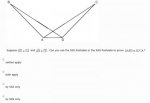You are using an out of date browser. It may not display this or other websites correctly.
You should upgrade or use an alternative browser.
You should upgrade or use an alternative browser.
Suppose line A equals line B and line C equals line D. Can you use the SSS Postulate.
- Thread starter DrGore
- Start date
- Joined
- Feb 4, 2004
- Messages
- 16,583
Suppose line A equals line B and line C equals line D. Can you use the SSS Postulate to prove triangle A equals triangle B?
What are your thoughts? What have you tried? How far have you gotten? Where are you stuck?
Please be complete. Thank you!
Dr.Peterson
Elite Member
- Joined
- Nov 12, 2017
- Messages
- 16,051
Suppose line A equals line B and line C equals line D. Can you use the SSS Postulate to prove triangle A equals triangle B?
I do not know how to start on this/how to prove that something is congruent by SSS or SAS.
I don't know what you mean here; in this problem, following the usual notation, A, B, C, and D are points, not lines or triangles!
Do you understand what the SSS Postulate means? It says that if each of the sides of one triangle is congruent to the corresponding side of the other, then you can conclude that the triangles are congruent.
Is that true of the two triangles they are asking about?
The more you tell us about what you already know, and where you are stuck, the better we can help.
I don't think that any of that is true for the above triangles. I don't see any congruent markers on it so I think that would make it number 1, "Neither Apply".I don't know what you mean here; in this problem, following the usual notation, A, B, C, and D are points, not lines or triangles!
Do you understand what the SSS Postulate means? It says that if each of the sides of one triangle is congruent to the corresponding side of the other, then you can conclude that the triangles are congruent.
Is that true of the two triangles they are asking about?
The more you tell us about what you already know, and where you are stuck, the better we can help.
What are your thoughts? What have you tried? How far have you gotten? Where are you stuck?
Please be complete. Thank you!
Looks like I edited it between the time of you opening it and replying to it
I know mostly nothing about this other than some rudimentary understanding of what congruency is.
I don't know what you mean here; in this problem, following the usual notation, A, B, C, and D are points, not lines or triangles!
Do you understand what the SSS Postulate means? It says that if each of the sides of one triangle is congruent to the corresponding side of the other, then you can conclude that the triangles are congruent.
Is that true of the two triangles they are asking about?
The more you tell us about what you already know, and where you are stuck, the better we can help.
I don't believe that any of the triangles have any congruent sides, and since there are none then it can't be any of them because they all require at least one side? So the first option of "Neither Apply" would be correct, yes?
Last edited:
Dr.Peterson
Elite Member
- Joined
- Nov 12, 2017
- Messages
- 16,051
I don't think that any of that is true for the above triangles. I don't see any congruent markers on it so I think that would make it number 1, "Neither Apply".
There are different ways to indicate that sides are congruent. In this case, nothing is marked; all the information apart from how parts are connected is stated in words or symbols. What does it say about congruent parts?
- Joined
- Feb 4, 2004
- Messages
- 16,583
So your class hasn't covered any of this material yet...? Is this some sort of pre-test at the beginning of the term...?I know mostly nothing about this other than some rudimentary understanding of what congruency is.
What then is the meaning of the "\(\displaystyle \cong\)" symbols in the "Suppose" statement? And, since AD must equal AD, how are this shared side not congruent to itself? :shock:I don't believe that any of the triangles have any congruent sides...
There are different ways to indicate that sides are congruent. In this case, nothing is marked; all the information apart from how parts are connected is stated in words or symbols. What does it say about congruent parts?
So your class hasn't covered any of this material yet...? Is this some sort of pre-test at the beginning of the term...?
What then is the meaning of the "\(\displaystyle \cong\)" symbols in the "Suppose" statement? And, since AD must equal AD, how are this shared side not congruent to itself? :shock:
Man, this is such a necro but I genuinely thought I had already replied to this thread thanking people. Well since I guess no good deed should ever go unthanked. Thank you both and everyone else who was super helpful! I really thought I had already thanked people, but yeah, I was able to solve the question so thank you very much so everyone!
Also yes, it's a credit recovery course so if I do well enough on pre-tests I can test out of the class. So I try to take pre-tests real slowly and teach myself (or get help learning) so I can test out.

